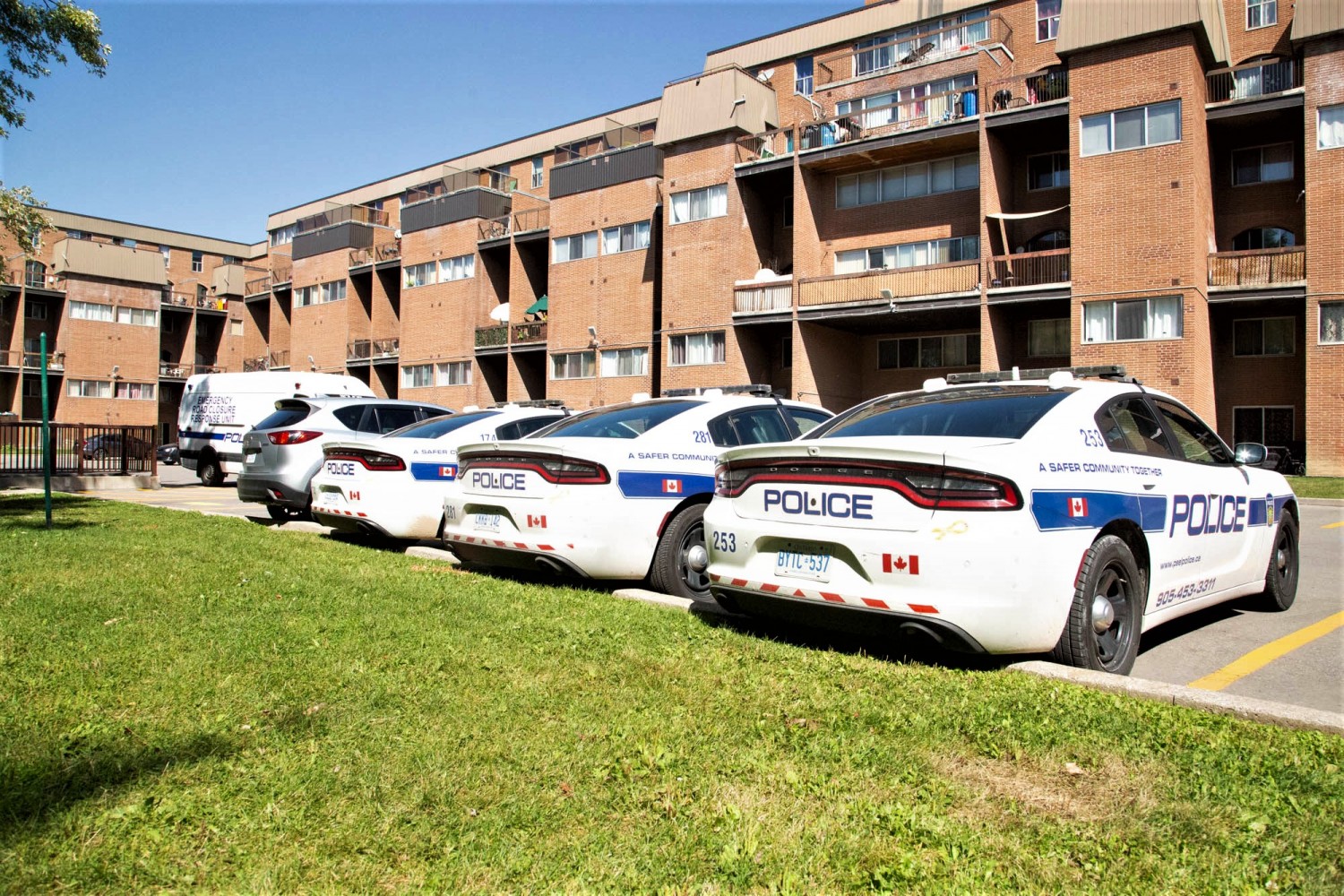
Documents show decades of Police neglect in Malton, now they’re in danger of ignoring it again
People are often philosophical about areas frozen in time – they see an illusion, almost. In Mississauga, places like the village of Streetsville work hard to hold onto their history and celebrate things that don’t change.
In other areas, though, the past is a painful reminder of neglect, in places that have long suffered.
In Malton, one of the more isolated parts of the city, patterns of neglect from the government and police have continued for at least the last 25 years.
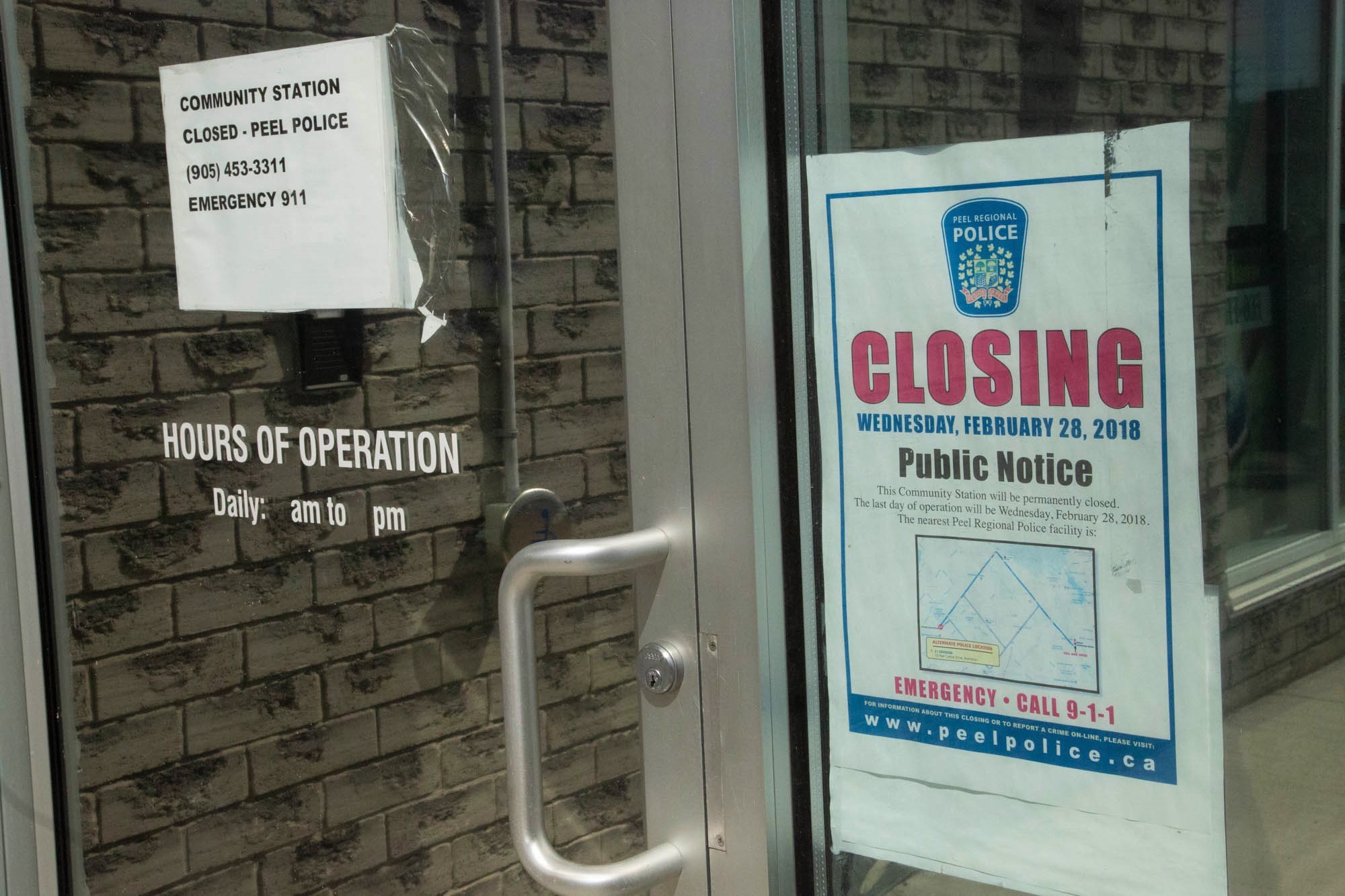
The sign at the Malton community station that was closed in February of 2018 still hung days after the mass shooting in September
According to census data, 59.9 percent of those who live in Malton are immigrants to Canada, while 82.5 percent are visible minorities. More than a third of households spend 30 percent or more of their income on rent, while one in five experience low-income.
In the past, authorities have ignored the area, which is isolated due to poor transit links, the vast Pearson Airport lands and giant corridors of industrial zoning. In September, the community pushed its way to the top of the national agenda after a shocking crime.
On September 14, a 17-year-old, Jonathan Davis, was killed in a shooting which grabbed headlines across the country after more than a 130 bullets were fired behind a busy apartment complex, leaving five others wounded. The jarring violence took place just a few minutes walk from where Westwood Square Mall community police station had been located before it was shut down in February 2018.
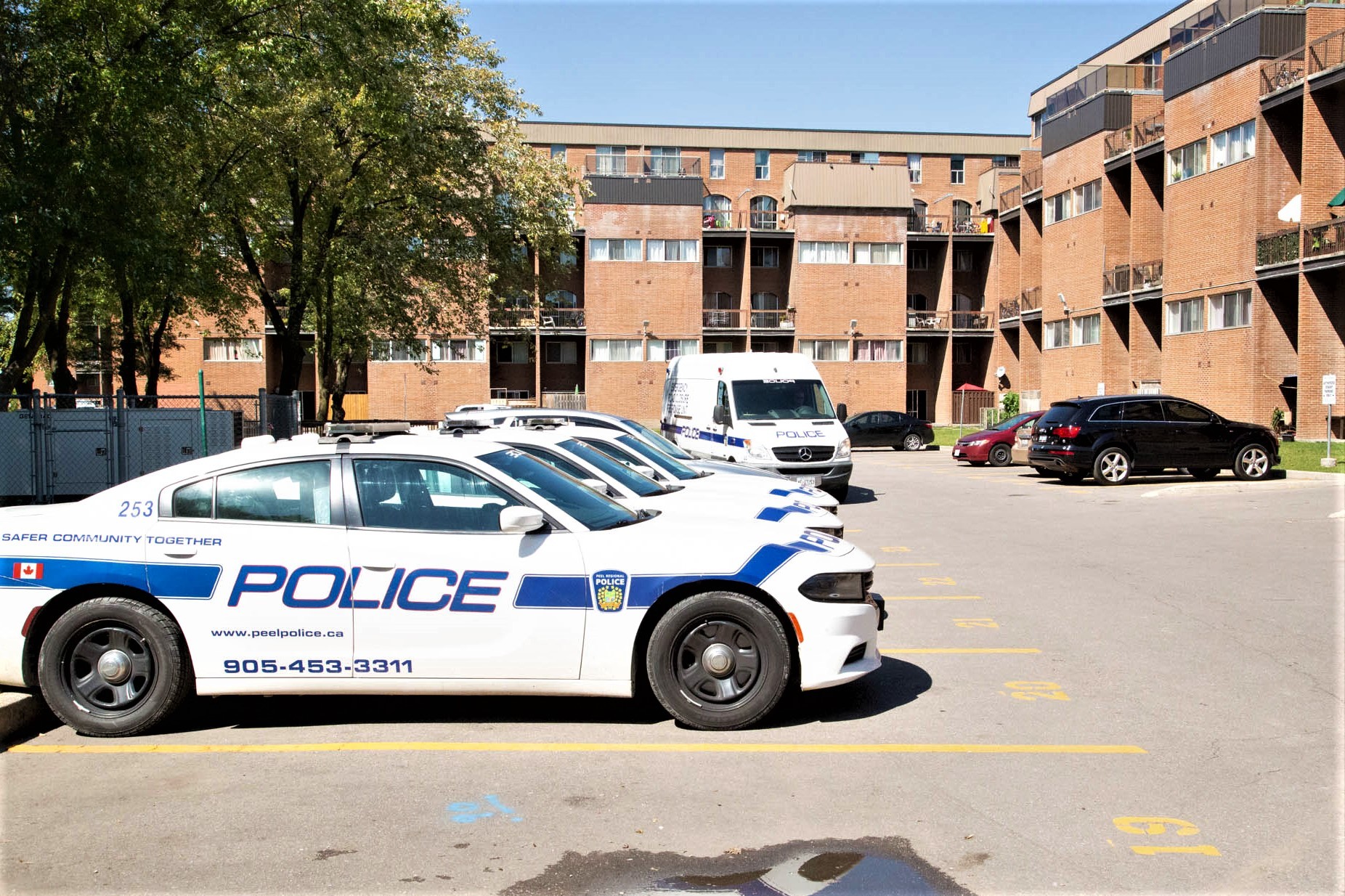
Police cruisers at the apartment complex where the Malton mass shooting occurred
Internal documents and correspondence from Peel Police reveal that the now-abandoned community police station was set-up as an insufficient placeholder in the first place. Meeting minutes and internal correspondence obtained by The Pointer show that Peel Regional Police identified Malton as a priority location for a full police division in the 1990s, before scuppering the project just six months before it was due to open in a difficult budget year.
A 1990 report will sound familiar to those who know the Malton area. It describes the case for a full Malton police division because of the community’s “relative isolation” thanks to industrial areas in the north and the presence of Pearson Airport. Making a case which is still applicable today, it says: “this situation is ideal for the application of Community Orientated Policing tactics.”
Plans for a specific Malton division, something considerably larger than the community station that the area was eventually given, appeared on record just one year prior to the report, in January 1989. At a meeting of the Peel Police Services Board, chaired by Miles Obradovich, staff presented the “justification” for a division to be set-up in Malton.
The urgent case for such a move was highlighted by the suggestion that temporary space should be leased during the construction of a division building, something which would allow police to begin operating out of Malton as early as possible.
In April of the same year, Peel Police moved toward further divisions, with plans to acquire several parcels of land as the region continued its rapid growth. Areas in Meadowvale, Malton and Bramalea (Brampton) were all identified as worthy of police divisions. Roadmaps were laid out to purchase the land, which ranged between $1 million and $1.6 million in value for each parcel. Money to fund the purchases was drawn largely from the force’s development fund.
Internal correspondence described this as a time which would herald a “philosophical change in style” with more community orientated policing, the flagship to which could have been a “highly visible” Malton police division. Yet, it was not to be.
In September 1995, documents from the Police Services Board list plans to call a meeting to cancel the Malton Division. Significant cuts at the provincial level that year created a shortfall of $4 million in the budget, with staff choosing to end plans for a Malton division altogether. Why they were not deferred, or put to further discussion through forums such as town halls, is unclear.
Heartbreakingly for the community, the much-needed police division had already been announced. In April of 1995, Peel Police called the community together to announce the station; by September that promise had already been broken. Internal correspondence described it as “not prudent” to continue with the creation of a Malton division as the force could not afford it. Instead, plans were accelerated to create the significantly smaller community station in Westwood Square Mall which was eventually closed in 2018, again for budget reasons, as then chief Jennifer Evans said the rent was too high, leaving Malton further isolated.
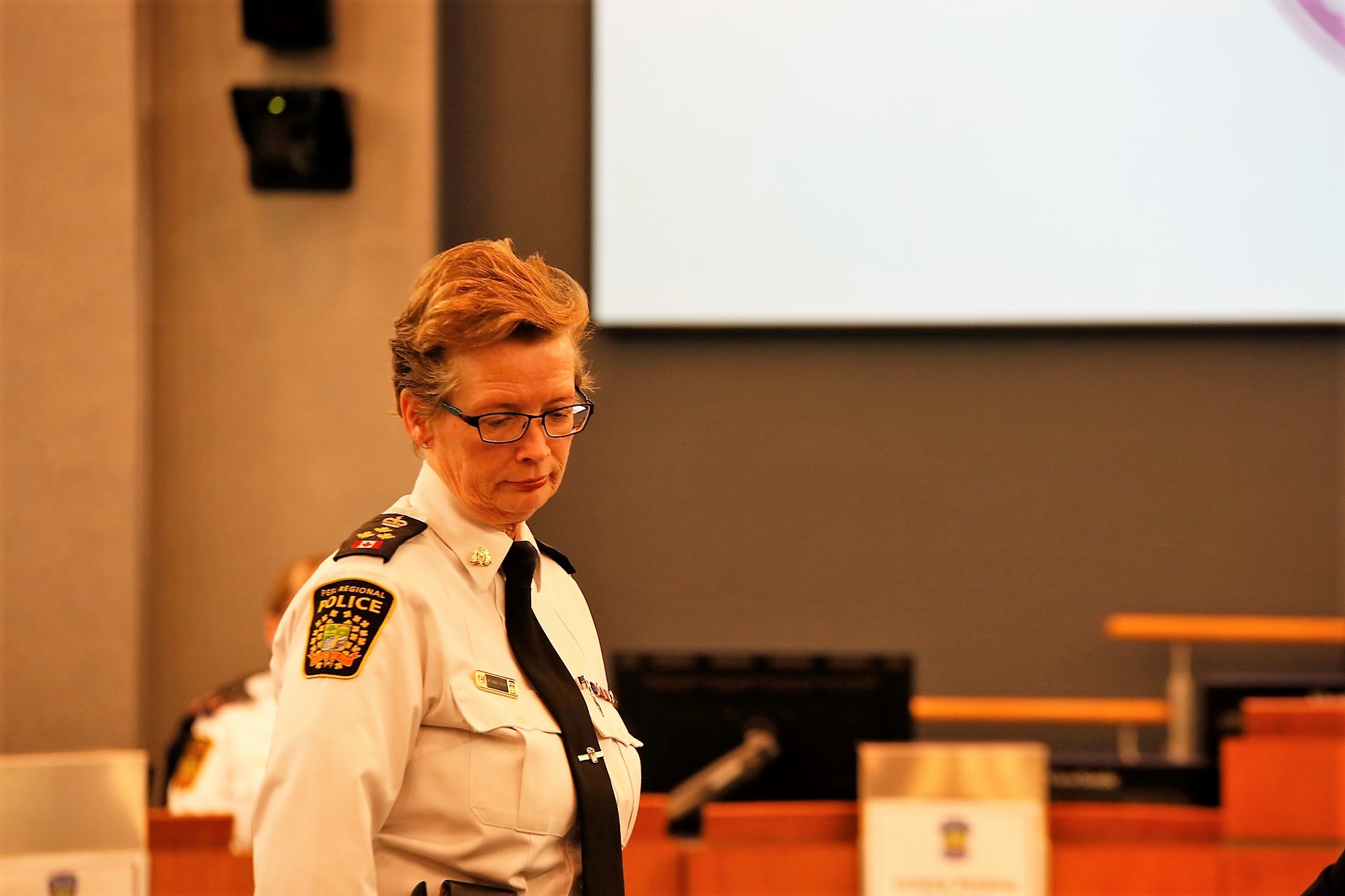
Former chief Jennifer Evans closed the Malton community station last year because of high rent
The decision was heartbreaking for the community, torn by rising violent crime over the past four years. But it was nothing short of embarrassing for the force. When the Malton division was completely cancelled decades ago, Peel Regional Police had already purchased the land required to build it, hired an architect to plan and model the building and were in the process of hiring a contractor. The plug was pulled less than a year before the division was due to open.
The projected capital cost of the project was $6.3 million, with the $1.6 million land parcel already acquired and Stafford Haensli Architects contracted for just over $256,000, when the axe fell.
Behind closed doors, systematic neglect of the area continued. In 1999, a “new capital project” was brought to the police board for an initial sum of $2.6 million. This project, which eventually became the Emil Kolb Training Centre on Derry Road, named after the former chair of the board and Peel Region, used funds which were not accounted for when Malton residents and community leaders asked what had happened to the original plans.
In September 1999, four years after the cancellation of the Malton division, Peel Police reported a budget surplus of $5.5 million. The money was eventually redistributed to various smaller projects, including salary savings, life insurance payments and community policing initiatives.
If it had been directed towards the cancelled Malton division, which still had designated land, architectural plans and a projected construction cost of $4.25 million, things could have played out differently.
The sorry state of affairs was concluded in 2001, when Peel Police sold off the now “surplus” land which had been designated for Malton’s badly needed police station to the Light Korean Presbetryan Church for $1.2 million, paying a 3.5 percent brokerage fee in the process, in order to “minimize” their loss.
More than 18 years after the sale, Malton remains one of the most neglected areas in the city, a problem compounded by the closure of its small community police station in February of 2018. That neglect by the top brass at Peel Police has played out over the past 30 years. In the 1990s, internal reports understood and identified exactly why Malton needed a police force: the area is isolated by the airport and industrial zoning, leaving its often transient community at risk to criminal enterprises that prey in such conditions where their activities often go unmonitored and where police response times are poor.
Now, with gang-style violence on the rise in Peel and a new police chief, the issue is front and centre again. Almost 30 years later, staff at the force are drawing together a report considering the creation of a Malton division which is likely to mirror its 30-year-old predecessor.
On September 27, Mississauga Mayor Bonnie Crombie, who sits on the police board, submitted a motion to the board requesting a review of police operations and services. In essence, it called into question the region’s current divisional model, something Crombie suggested is outdated due to Peel’s rapid population growth.
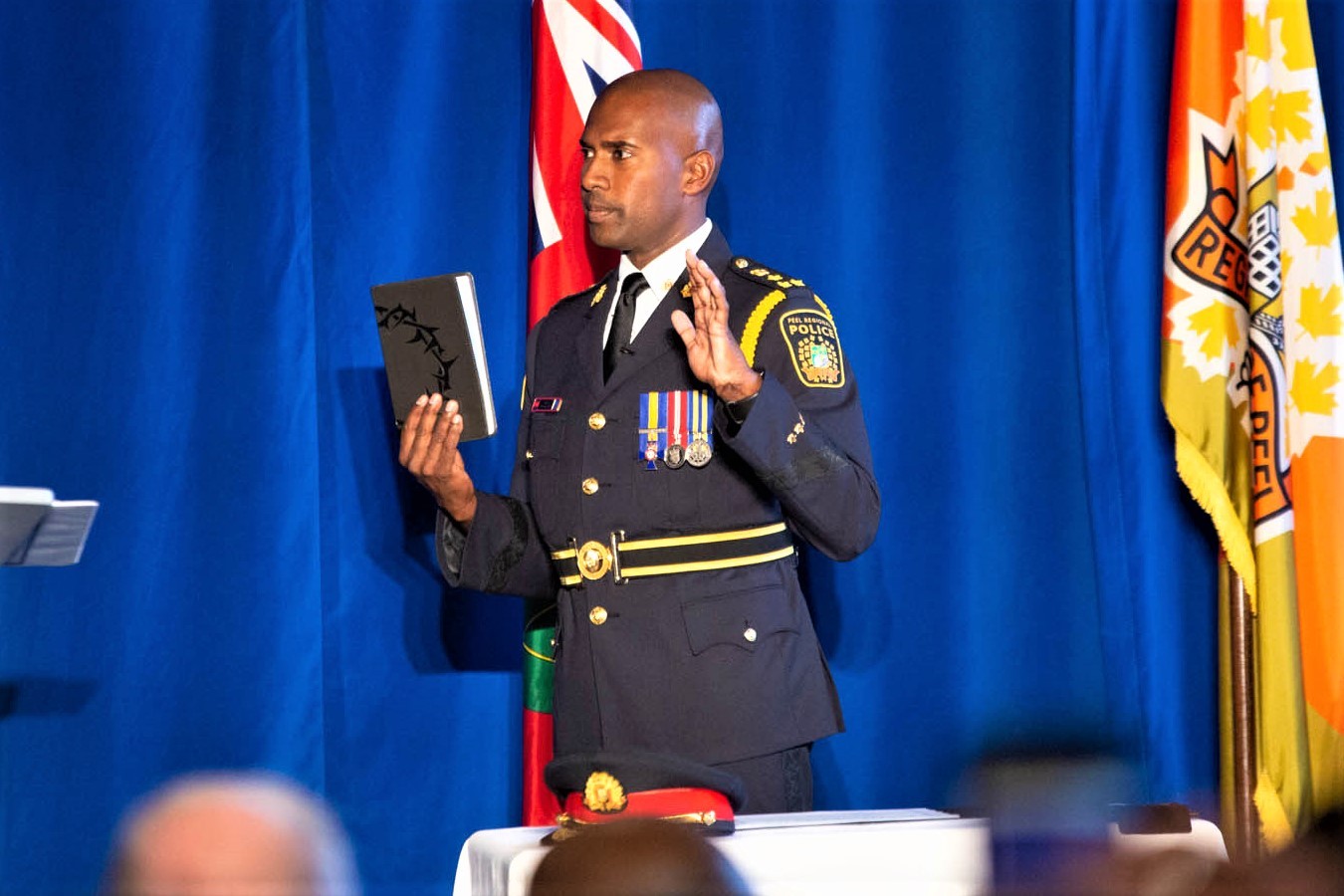
New Chief of Police, Nish Duraiappah, says he is open to an expanded police presence in Malton
Peel’s new Chief of Police, Nish Duraiappah, was sworn in last month. Asked by The Pointer, he said that he would not rule out reopening the community station or a larger police building after the location in Westwood Square was closed last year, a welcome prospect for the community.
With the force’s own statistics showing violent crime is on the rise and with local headlines dominated by accounts of shootings, bank robberies and assaults, the community remains on edge. Duraiappah, who is still settling into the job, has yet to announce official plans for Malton to get its community station back, though he has already confirmed a similar pledge for a station in downtown Brampton.
The local Malton Councillor, Carolyn Parrish, is unlikely to sit back and accept further neglect. The fiery former Liberal MP has already collected about 5,000 signatures from residents demanding a police division, instead of the community station.
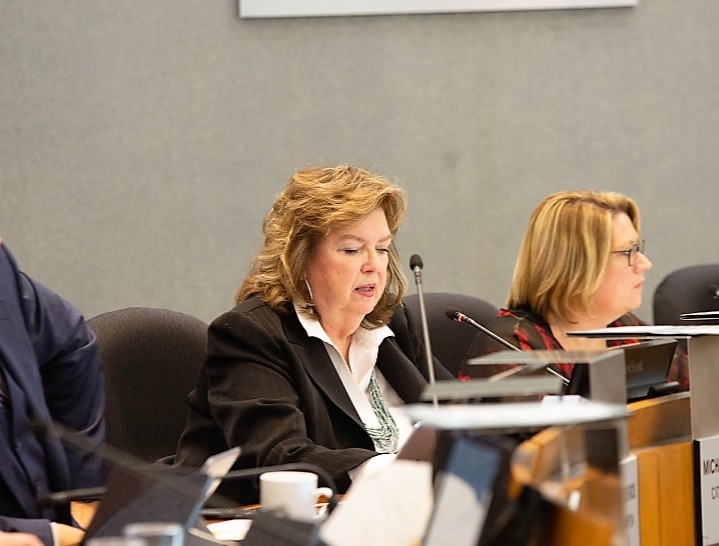
Malton-area Councillor Carolyn Parrish
If Peel Police decide to move ahead with reinstating the community station instead of building a full division, there are also options on the table which Parrish is signalling. Westwood Square Mall, in particular, is desperate to have the security of a permanent police presence back.
Since the station closed in 2018, it has kept rent-free space open to the force to use as a substation and mall administration has told the force that rent is “fully negotiable” after the decision to pull out because of cost. This means that Peel Police are in a strong position to open a cost-effective presence in Malton again almost immediately.
After the police invested nearly $2 million in a much larger project that never went forward, those who signed the petition expect a much larger, around the clock police presence, with much more strategic patrolling and proactive intelligence work to fight rising organized crime in the area.
It took the death of an innocent 17-year-old to alert government officials and police figures to a problem Malton and its local councillor were talking about for years.
Email: [email protected]
Twitter: @isaaccallan
Submit a correction about this story


